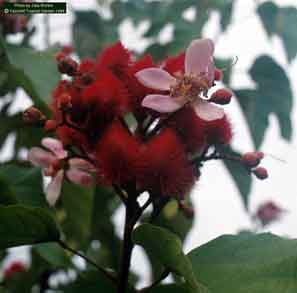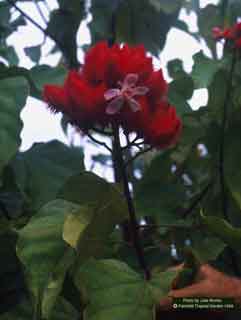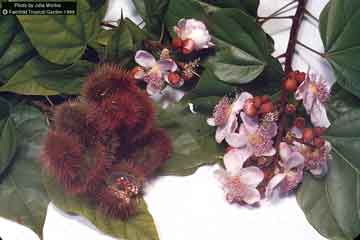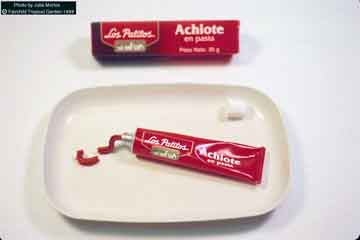 |
| Plant with flowers and developing fruit |
Bixa orellana L.
Heather Newman
 |
| Plant with developed fruits and flower |
Description: Botanical Characteristics
Bixa orellana L. is a shrub or bushy tree which ranges from 3 to 10 meters in height. Its glossy, ovate leaves are evergreen with reddish veins; they have a round, heart-shaped base and a pointed tip. With a thin, long stem, the leaves are between 8 and 20 cm long and 5 and 14 cm wide. The twigs are covered with rust colored scales when young and bare when older. Bixa’s flowers are pink, white, or some combination, and are 4 to 6 cm in diameter. From the flower protrudes a striking two-valved fruit, covered either with dense soft bristles or a smooth surface. These round fruits, approximately 4 cm wide, appear in a variety of colors: scarlet, yellow, brownish-green, maroon, and most commonly bright red. When ripe, they split open and reveal a numerous amount of small, fleshy seeds, about 5 mm in diameter and covered with red-orange pulp, the embryo of which is poisonous (Chopra 1949).
Origin and Distribution
Bixa orellana can be found in regions spanning the globe. Grown from either seed or cutlings, B. orellana requires full sunlight and protection from the wind (Morton 1974). The plant grows equally well in lowlands and mountainous regions or areas of higher elevation (Bruggeman 1957). Native to the tropical American area, B. orellana is found in largest quantities from Mexico to Ecuador, Brazil, and Bolivia. This plant is cultivated in warm regions of the world, such as India, Sri Lanka, and Java (Wolf 1997) mainly for the dye which the seeds yield. Bixa has been found in and about the towns of the Philippines (Quisumbing 1951), southeastern Africa (Williamson 1955), and Dominica (Honychurch 1980), and is commonly planted in Florida as an ornamental. There are a variety of common names for B. orellana because it flourishes in a variety of places. It is most frequently called “annato” or “achiote” in North America. Some of its other common names around the world are as follows: “changuarica,” “k’u-zub,” and “pumacua” (Mexico), “annato” and “urucu” (Brazil), “urucum” (Germany), “roucou” (Dominica and the French West Indies), “achiot” (Colombia), and “arnotto” (Amerindian).
Table of Medicinal Uses
| Ailments | Country used | Remedy | How to Use | References |
| Aids in healing of minor wounds and burns, prevents scaring and blisters | Mixture of red pulp and oil | Apply to skin | Leeuwenberg 1987, Morton 1981, Quisumbing 1951 | |
| Ailments of the womb or uterus and a female aphrodisiac | Decoction of leaves and red coloring matter | Drink | Morton 1981 | |
| Antidote to prussic acid poisoning | Northwest Amazonia | Dye | Drink | Morton 1981, Schultes & Raffauf 1990 |
| Anti-inflammatory | Decoction | Honychurch 1980, Martinez 1959 | ||
| Asthma, pleurisy, labored breathing | Decoction of leaves | Drink | Morton 1981 | |
| Astringent | Pulp surrounding seeds | Quisumbing 1951 | ||
| Bring out measles quickly, relieves stomachaches and asthma | Seed pulp dissolved in warm water | Drink | Morton 1981 | |
| Burn treatment | Uruguay | Seeds ground and boiled in oil | Apply to burns | Quisumbing 1951 |
| Certain skin diseases | Philippines | Red, resinous substance of seeds | Quisumbing 1951 | |
| Antipyretic and antiperiodic | Philippines | Root-bark | Quisumbing 1951 | |
| Cleanse from poisoning and to refresh | Leaves in baths | Go in bath | Ayensu 1981, Honychurch 1980 | |
| Diabetes, flu, venereal diseases | West Indies | Aqueous and rum infusions of root | Drink | Ayensu 1981 |
| Digestive properties | Root | Schultes & Raffauf 1990 | ||
| Diuretic, purgative, treats gonorrhea | Gum made from crushed leaves mixed with water (ingest) | Swallow | Martinez 1959, Morton 1981, Quisumbing 1951 | |
| Diuretic, treatment of jaundice, diabetes, influenza and venereal diseases | Trinidad | Root decoction | Drink | Morton 1981 |
| Dysentery | Yucatan | Root decoction | Drink | Morton 1981 |
| Febrifuge | Cambodia | Leaves | Quisumbing 1951 | |
| Fevers | Philippines | Root-bark | Quisumbing 1951 | |
| Halt diarrhea and shrink hemorrhoids | Decoction of empty seed capsule | Drink | Morton 1981 | |
| Headaches | Leaves oiled | Apply to forehead | Leeuwenberg 1987, Morton 1981, Quisumbing 1951 | |
| Inflammation, colic, or the heat | Leaves (3-7) boiled with sugar | Drink | Ayensu 1981, Honychurch 1980 | |
| Jaundice remedy | Decoction (sweetened) of seeds | Drink | Ayensu 1981, Morton 1981, Quisumbing 1951 | |
| Kidney diseases | Pulp surrounding seeds | Quisumbing 1951 | ||
| Leprosy treatment | Central America | Oil derived from seeds | Chopra 1949, Morton 1981, Quisumbing 1951 | |
| Liver trouble | Venezuela | Decoction of leafy branch tips | Drink | Morton 1981 |
| Oral and throat inflammation | Decoction of leaves | Drink | Morton 1981 | |
| Purgative in dysentery | French Guiana | Seed infusion | Quisumbing 1951 | |
| Snake bite | Leaves | Quisumbing 1951 | ||
| Sore throat | Decoction of Leaves | Gargle | Morton 1981 | |
| Stomachache | Pulp | Morton 1981, Quisumbing 1951 | ||
| Stops nausea and vomiting | Surinam | Decoction of leaves | Drink | Morton 1981 |
| Throat relief | Philippines | Mix dye with coconut | Apply to throat | Quisumbing 1951 |
| Worms for children | Decoction of Leaves | Drink | Ayensu 1981, Honychurch 1980 |
 |
| Plant with mature fruit and flower |
Food and Other Uses
The dye obtained from the pulp of the B. orellana seed (called bixin) is used all over the world as a red-orange dye for coloring rice, cheeses, soft drinks, oil, butter, and soup. The dye is also used in some regions to dye textiles (Morton 1981; Ledin 1952) and the Sionas and Secoyas color fabrics and weapons with it (Schultes & Raffauf 1990). In the Philippines, the red pulp from the seeds is used in the as polish for russet leather (Quisumbing 1951) and the seeds are ground and used as a condiment (Magness et al. 1971). Various indigenous groups paint their hair and bodies with the pulp to repel insects and protect from sunburn. Bixin was also the original Amerindian warpaint (Mabberly 1987). The seeds are given to bulls to make them aggressive for bullfighters and are taken by indians as an aphrodisiac (Morton 1981). A fiber may be obtained from the bark (Quisumbing 1951). A flagellate of the family Trypanosamatidae has been isolated from the fruit of B. orellana
(Fernandez-Ramos et al. 1999). Average price of seeds exported from Brazil in 1987 was $1.57 per kilogram, and as production increases, prices remain low (Wolf 1997). It has been found recently that particle attrition and impact rather than solvent extraction is a more cost efficient method for processing the red carotenoid bixin (Passos et al. 1998).
 |
| Paste with coloring from B. orellana seeds (bixin) |
Chemical Constituents
Bixa orellana exhibited some level of antifungal activity when a group of Latin American plants were subjected to screening for antifungal activity (Freixa et al. 1998). In another experiment, the lipid fraction of B. orellana seeds was extracted using n-hexane and isolated by thin-layer chromatography; it seems that Bixa seeds contain a higher concentration of delta-tocotrienol than any other vegetable species (Frega, Mozzon & Bocci 1998). Recently, three apocarotenoids were isolated from annato (B. orellana) and synthesized. They were: methyl (9Z)-8’-oxo-6, 8’diapocarten-6-oate (2), methyl Z)-10’-oxo-6, 10’diapocaroten-6-oate (4), and methyl (9Z)-14’-oxo-6,14’-diapocaroten-6-oate (5) (Haberli & Pfander 1999). In another experiment, three minor cartenoids were isolated from the seed coat of B. orellana fruits by chromatographic methods and, for the first time, geranylgeraniol has been found esterified with a carotenoid carboxylic acid (Mercadante, Steck & Pfander 1999).
Literature cited:
Bruggeman, L. 1957.
Tropical Plants and Their Cultivation.
New York: 157, plate [222].
Chopra, R. N. 1949.
Poisonous Plans of India.
Delhi, India: 203-210.
Fernandez-Ramos, C., F. Luque, C. Fernandez-Becerra, A. Osuna, S. Jankevicius, J. Jankevicius, M. Rosales & M. Sanchez-Moreno. 1999.
Biochemical characterisation of flagellates isolated from fruits and seeds from Brazil.
Fems Microbiology Letters. 170 (2): 343-348.
Frega, N., M. Mozzon, & F. Bocci. 1998.
Identification and estimation of tocotrienols in the annatto lipid fraction by gas chromatography mass spectrometry.
Journal of the American Oil Chemists Society. 75 (12): 1723-1727.
Freixa, B., R. Vila, L. Vargas, N. Lozano, T. Adzet & S. Canigueral. 1998.
Screening for antifungal activity in nineteen Latin American plants.
Phytotherapy Research.12(6): 427-430.
Haberli, A. & H. Pfander. 1999.
Synthesis of bixin and three minor carotenoids from annato (Bixa orellana).
Helvetica Chemica Acta.82 (5): 696-706.
Honychurch, P. N. 1980.
Caribbean Wild Plants and Their Uses
Canada: 16.
Mabberley, D.J. 1987.
The Plant Book.
Cambridge, MA: 70.
Magness, J.R., G.M. Markle, C.C. Compton. 1971.
Food and feed crops of the United States.
Interregional Research Project IR-4, IR Bul. 1 (Bul. 828 New Jersey Agr. Expt. Sta.).
fide http://www.hort.purdue.edu/newcrop/Crops/achiote.html
Mercadante, A., A. Steck & H. Pfander. 1999.
Three minor Carotenoids from annatto (Bixa orellana) seeds.
Phytochemistry.52 (1): 135-139.
Morton, J. 1981.
Atlas of Medicinal Plants of Middle America.
Springfield, Illinois: 572-573.
Morton, J. 1974.
500 Plants of South Florida.
Miami, FL: 33.
Morton, J. & R. B. Ledin. 1952.
400 Plants of South Florida.
Coral Gables, FL: 25.
Passos, M., L. Oliveira, A. Franca & G. Massarani. 1998.
Bixin powder production in conical bed units.
Drying Technology.16 (9-10): 1855-1879.
Quisumbing, E. 1951.
Medicinal Plants of the Philippines.
Manila: 623-624.
Schultes, R. & R. Raffauf. 1990.
The Healing Forest: Medicinal and Toxic Plants of the Northwest Amazonia.
Portland, Oregon: 109-111.
Williamson, J. 1955.
Useful Plants of Nyasaland.
Zomba, Nyasaland: 23.
Wolf, M. A. 1997.
http://home.braunschweig.netsurf.de/~andree.wolf/urucum.html
Other Useful Resources:
Ayensu, E. S. 1981.
Medicinal Plants of The West Indies.
Michigan: 54-56.
Leeuwenberg, A.J.M. 1987.
Medicinal Plants of The Tropics.
Netherlands: 119.
Martinez, M. 1959.
Plantas Medicinales de Mexico.
Mexico: 24-26.
Meyer, C. 1977.
The Herbalist Almanac.
Illinois: 40.